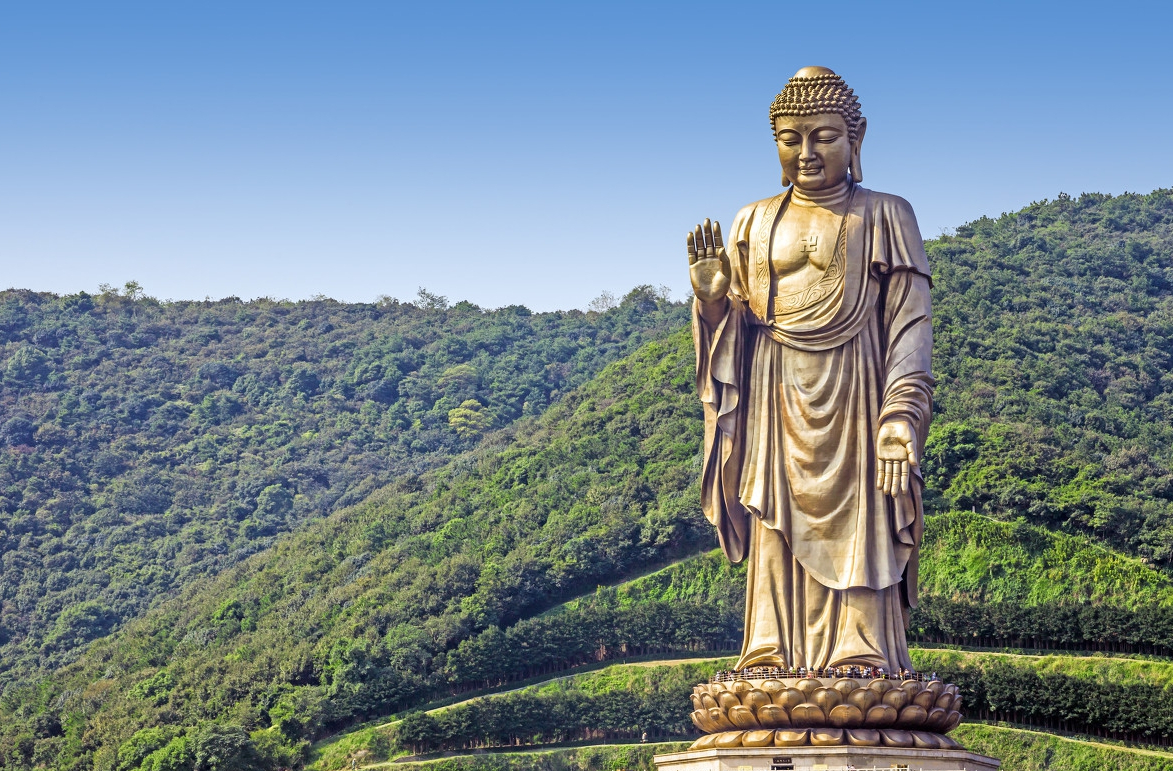
佛教,起源于远古印度迦毗罗卫国(现在的尼泊尔)的太子悉达多·乔达摩(佛号释迦牟尼)在大约西元前6世纪对于佛弟子所开示的教导,后发展为宗教。全世界约有5亿佛教信众[1][2][3][4][5][6][7][8],常被视为世界三大宗教之一。在世界上尤其是对于东亚、中亚、东南亚和南亚地区曾具有广泛的影响。世界佛教各派别占佛教信徒的人口比例是:大乘佛教56%,上座部佛教38%,密宗6%。[9]
佛,意思是“觉者”[10]。佛又称如来、应供、正遍知、明行足、善逝、世间解、无上士、调御丈夫、天人师、世尊[11]。佛教重视人类心灵和道德的进步和觉悟。按照佛教的观点,人和其他众生一样,沉沦于苦迫之中,并不断的轮转生死。惟有断除无明的人才能出三界脱离轮回。悉达多·乔达摩就在35岁时成佛,并对众人宣扬他所发现的道理。佛教信徒修习佛教的目的即在于从悉达多所悟到的道理里,看透生命和宇宙的真相,最终超越生死和苦、断尽一切烦恼,得到究竟解脱。
佛教(英语:Buddhism)起源于古印度河流域迦毗罗卫国(今尼泊尔和印度边界间靠近尼泊尔)的王室太子悉达多·乔答摩于35岁修道成为释迦牟尼佛后在约前6世纪对弟子开示的“苦的止息、趣(趋)向涅槃”的教导内容,后宗教化,为现代世界三大宗教之一。对于世界上,尤其是东亚、东南亚文化具有深刻的影响,此外在中亚和南亚地区文化曾具有广泛的影响,现正在向欧洲、非洲、北美洲发展。佛教经历史发展,通过南、北两条传播途径,现代存在南传上座部佛教、北传大乘佛教两条支脉,其中大乘佛教又分为显宗(汉传佛教的主要内容)和密宗(藏传佛教的主要内容),故也有上座部、汉传佛教(大乘)、藏传佛教(金刚乘)三分法[注 1],各脉又有诸多宗派;南传主要为以声闻乘阿罗汉果为最高圣位,北传则追求在未来世成佛,皆称为涅槃。
教主为释迦牟尼佛,广义上也包含三世诸佛,一般尊称其为佛陀,义为觉者、觉悟者。佛教的本意是佛陀的教育,而不是指拜神佛的宗教,比起其他宗教教义更像是一种哲理,这是由于最原始的佛教概念中,没有明确指出神明的定义甚至反对迷信,因而后世的佛教尽管有些神话故事与规范,始终带有一些不可知论的气息,佛陀认为不应该浪费时间思考对灭苦没帮助的概念。佛教在历史上曾对世界文化传播做出了不可磨灭的贡献。佛教重视人类心灵和道德的进步和觉悟。按照佛教的观点,人和其他六道众生一样,沉沦于苦迫之中,并不断的轮转生死,惟有断除无明的人才能出三界离轮回。教徒修习佛教的目的即在于追随并实践悉达多所觉悟的四圣谛,看透生命和宇宙的真相,断尽一切烦恼,最终超越生老病死和所有苦结束轮回,得到究竟解脱进入涅槃。
2010年普查显示全世界约有5亿佛教徒[1][2][3][4][5][6][7][8]。21世纪世界佛教徒的人口分布是:汉传佛教地区67.3%(3.6亿人),南传佛教地区28%(1.5亿人),藏传佛教地区3.4%(1800万人),亚洲以外地区1.3%(700万人)。[9]
Der Buddhismus ist eine Lehrtradition und Religion, die ihren Ursprung in Indien hat. Sie hat weltweit je nach Quelle zwischen 230 und 500 Millionen[1][2][3] Anhänger – und ist damit die viertgrößte Religion der Erde (nach Christentum, Islam und Hinduismus). Der Buddhismus ist hauptsächlich in Süd-, Südost- und Ostasien verbreitet. Etwa die Hälfte aller Buddhisten leben in China.[4]
Die Buddhisten berufen sich auf die Lehren des Siddhartha Gautama, der in Nordindien lebte, nach den heute in der Forschung vorherrschenden Datierungsansätzen im 6. und möglicherweise noch im frühen 5. Jahrhundert v. Chr. Er wird als der „historische Buddha“ bezeichnet, um ihn von den mythischen Buddha-Gestalten zu unterscheiden, die nicht historisch bezeugt sind. „Buddha“ (wörtlich „Erwachter“) ist ein Ehrentitel, der sich auf ein Erlebnis bezieht, das als Bodhi („Erwachen“) bezeichnet wird. Gemeint ist damit nach der buddhistischen Lehre eine fundamentale und befreiende Einsicht in die Grundtatsachen allen Lebens, aus der sich die Überwindung des leidhaften Daseins ergibt. Diese Erkenntnis nach dem Vorbild des historischen Buddha durch Befolgung seiner Lehren zu erlangen, ist das Ziel der buddhistischen Praxis. Dabei wird von den beiden Extremen selbstzerstörerischer Askese und ungezügeltem Hedonismus, aber auch generell von Radikalismus abgeraten, vielmehr soll ein Mittlerer Weg eingeschlagen werden.[5]
仏教(ぶっきょう、旧字体: 佛敎、サンスクリット: बौद्धधर्मः 、英語: Buddhism)は、インドの釈迦(ゴータマ・シッダッタ、もしくはガウタマ・シッダールタ、ゴータマ・シッダールタ)を開祖とする宗教である。キリスト教・イスラム教と並んで、日本では出版点数の多い宗教の一つに数えられる[注釈 1]。仏陀(仏、目覚めた人)の説いた教えである[注釈 2]。
その教義は、苦しみの輪廻から解脱することを目指している。原因と結果の理解に基づいており、諸々の現象が縁起するとされる。
仏教は仏、その教えである法、その実践者である僧からなる三宝を中心に組織されている。実践における戒定慧の三学は、戒律、心を集中する禅定、ものごとの縁起を観察する智慧であり、後ろ二つは併せて止観とも呼ばれる仏教の瞑想法である。実践にて重要となる能力は六波羅蜜や八正道のように、いくつかの方法でまとめられている。
紀元前450年ごろに、インドで開始された仏教は、今では初期仏教として研究されている。釈迦は、他の苦行などの実践者の主張であるアートマン(真我)の存在を否定して無我とした。釈迦の死後数百年で部派仏教が生まれ、大きく大衆部と上座部とに、さらに細かく分かれたが、今なお大きな勢力として続いているのは南伝した上座部仏教であり、初期の教えを模範としている。紀元前の終わりごろには北伝し日本にも伝わることになる大乗仏教が開始され、教義や団体は多彩に発展しており、禅の瞑想法の様々、チベットや日本の真言宗に残る密教、一方で浄土信仰のような信仰形態の変化など多様である。なお、『日本書紀』によれば仏教が伝来したのは飛鳥時代552年(欽明天皇13年)である(日本の仏教)。
Buddhism (/ˈbʊdɪzəm/, US also /ˈbuːd-/)[1][2] is the world's fourth-largest religion[3][4] with over 520 million followers, or over 7% of the global population, known as Buddhists.[web 1][5] Buddhism encompasses a variety of traditions, beliefs and spiritual practices largely based on original teachings attributed to the Buddha and resulting interpreted philosophies. Buddhism originated in ancient India as a Sramana tradition sometime between the 6th and 4th centuries BCE, spreading through much of Asia. Two major extant branches of Buddhism are generally recognized by scholars: Theravada (Pali: "The School of the Elders") and Mahayana (Sanskrit: "The Great Vehicle").
Most Buddhist traditions share the goal of overcoming suffering and the cycle of death and rebirth, either by the attainment of Nirvana or through the path of Buddhahood.[6][7][8] Buddhist schools vary in their interpretation of the path to liberation, the relative importance and canonicity assigned to the various Buddhist texts, and their specific teachings and practices.[9][10] Widely observed practices include taking refuge in the Buddha, the Dharma and the Sangha, observance of moral precepts, monasticism, meditation, and the cultivation of the Paramitas (virtues).
Theravada Buddhism has a widespread following in Sri Lanka and Southeast Asia. Mahayana, which includes the traditions of Pure Land, Zen, Nichiren Buddhism, Shingon and Tiantai (Tendai), is found throughout East Asia.
Vajrayana, a body of teachings attributed to Indian adepts, may be viewed as a separate branch or as an aspect of Mahayana Buddhism.[11] Tibetan Buddhism, which preserves the Vajrayana teachings of eighth-century India, is practiced in the countries of the Himalayan region, Mongolia,[12] and Kalmykia.[13]
Le bouddhisme est une religion (notamment une religion d'État) ou, selon le point de vue occidental, une philosophie, voire les deux, dont les origines sont en Inde au Ve siècle av. J.-C. à la suite de l'éveil de Siddhartha Gautama et de son enseignement.
Le bouddhisme comptait en 2005 entre 230 millions et 500 millions d'adeptes1, ce qui en fait la quatrième religion mondiale, derrière (dans l'ordre décroissant) le christianisme, l'islam et l'hindouisme. L'historien des religions Odon Vallet mentionne que c'est « la seule grande religion au monde à avoir régressé au XXe siècle », en raison, notamment, des persécutions du bouddhisme en Chine et en Indochine par les régimes communistes2.
Le bouddhisme présente un ensemble ramifié de pratiques méditatives, de rituels religieux (prières, offrandes), de pratiques éthiques, de théories psychologiques, philosophiques, cosmogoniques et cosmologiques, abordées dans la perspective de la bodhi, « l'éveil ». À l'instar du jaïnisme, le bouddhisme est à l'origine une tradition shramana, et non brahmanique comme l'est l'hindouisme.
Les notions de dieu et de divinité dans le bouddhisme sont particulières : bien que le bouddhisme soit souvent perçu comme une religion sans dieu créateurn 1, la notion étant absente de la plupart des formes du bouddhismen 2, la vénération et le culte du Bouddha historique Siddhartha Gautama en tant que bhagavat joue un rôle important dans le Theravāda et également dans le Mahāyāna, dans lesquels il est un être éveillé ayant trois aspects ou manifestations (trikāya).
Il buddhismo o più comunemente buddismo [2] (sanscrito: buddha-śāsana) è una delle religioni[3][4] più antiche e più diffuse al mondo. Originato dagli insegnamenti dell'asceta itinerante indiano Siddhārtha Gautama (VI, V sec. a.C.), comunemente si compendia nelle dottrine fondate sulle Quattro nobili verità (sanscrito: Catvāri-ārya-satyāni).
Con il termine buddhismo si indica quindi quell'insieme di tradizioni, sistemi di pensiero, pratiche e tecniche spirituali, individuali e devozionali, nate dalle differenti interpretazioni di queste dottrine, che si sono evolute in modo anche molto eterogeneo e diversificato[5][6].
Sorto nel VI-V secolo a.C. come disciplina spirituale assunse nei secoli successivi i caratteri di dottrina filosofica e, secondo alcuni autori, di religione "ateistica"[7], intendendo con quest'ultimo termine non la negazione dell'esistenza degli dèi (deva), quanto piuttosto il fatto che la devozione ad essi, fatto comunque considerato positivo, non condurrebbe alla liberazione ultima. Altri considerano i libri sacri buddhisti (Canone pāli, Canone cinese e Canone tibetano) testi che non divinizzano Siddhartha Gautama Buddha Śākyamuni, ma Adi-Buddha o Buddha eterno, concetti buddhisti equivalenti a Dio.
A partire dall'India il buddhismo si diffuse nei secoli successivi soprattutto nel Sud-est asiatico e in Estremo Oriente, giungendo, a partire dal XIX secolo, anche in Occidente.
El budismo es una «doctrina filosófica y espiritual»23 no teísta perteneciente a la familia dhármica, derivada del brahmanismo y, según el vedismo, de tipo nástika.4 Comprende una variedad de tradiciones, creencias religiosas y prácticas espirituales principalmente atribuibles a Buda Gautama. El budismo se originó en la India entre los siglos VI y IV a. C., desde donde se extendió a gran parte del este de Asia y declinó su práctica en el país de origen durante la Edad Media. Existen dos ramas principales del budismo: Theravada (Escuela de los Ancianos) y Mahāyāna (El Gran Camino). El budismo es la cuarta religión más importante del mundo con más de 500 millones de adeptos, es decir el 7 % de la población mundial.
Las diferentes ramas del budismo difieren acerca de la exacta naturaleza del camino a la liberación; la importancia y el valor canónico de varias escrituras y enseñanzas, auto conocimiento y, especialmente, en las respectivas prácticas del budismo. Estas prácticas incluyen el Refugio Espiritual, la Samatha, Vipassana, Bodhicitta y las prácticas de la Vajrayāna del Estado de Generación y el Estado de Terminación. Fundamentalmente, el budismo contempla el estudio de las Escrituras budistas, observar los principios morales, renunciar a lo material, la práctica de la Meditación, cultivar la sabiduría, la bondad y la compasión, la práctica Mahāyāna de la Bodhicitta y las prácticas Vajrayāna del Estado de Generación y el Estado de Terminación.
En Theravada el objetivo final es lograr la cesación de las kleshas (estados destructivos mentales, incluyendo la ignorancia, la adhesión a lo material y la aversión) para lograr el sublime estado de Nirvana (espiritualidad) mediante la práctica de las Ocho Nobles Verdades (también conocido como el Camino del Medio), liberándose de esta forma del ciclo de sufrimiento y renacimiento. Therevada se sigue principalmente en Sri Lanka y el Sudeste de Asia.
La Mahāyāna incluye las tradiciones de Tierra Pura, Zen, Nichiren Budista, Budismo Shingon y Escuela Budista del Tiantai que tiene amplio seguimiento en todo el este de Asia. En lugar del Nirvana (espiritualidad), las enseñanzas de Mahāyāna se dirigen a lograr el estado de Buda (concepto) siguiendo el camino Bodhisattva, un estado donde se permanece en un ciclo de renacimiento para ayudar a otros a lograr su despertar al camino budista.
La Vajrayana cubre enseñanzas atribuidas a los indios Siddha y podría considerarse como una tercera rama del budismo o bien parte de la Mahāyāna. El budismo del Tíbet conserva las enseñanzas de la India del siglo VIII y se practica también en las regiones aledañas al Himalaya, en Mongolia y en Kalmukia. El budismo tibetano aspira al estado de Buda (concepto) o el llamado Cuerpo del Arco Iris ('ja' lus).
Derivado del movimiento Sramana, el budismo fue fundado en la India en el siglo VI a. C. por Buda Gautama2 y ha ido evolucionando hasta adquirir gran diversidad en escuelas y prácticas actuales. Se encontraron ciertas dificultades para definir el budismo en Occidente.
Будди́зм (санскр. बुद्ध धर्म, buddha dharma IAST; пали बुद्ध धम्म, buddha dhamma, «Учение Просветлённого»[1]; кит. 佛教 fójiào) — религиозно-философское учение (дхарма) о духовном пробуждении (бодхи), возникшее в середине 1-го тысячелетия до н. э. в Древней Индии. Основателем учения считается Сиддхартха Гаутама, впоследствии получивший имя Будда Шакьямуни[2].
Сами последователи этого учения называли его «Дхарма» (Закон, Учение) или «Буддхадхарма» (Учение Будды). Термин «буддизм» был создан европейцами в XIX веке[3]. Различные исследователи определяли буддизм по-разному, — как религию, философию, этическое учение, культурную традицию, цивилизацию, образование[4], как «науку о сознании»[5][6][4].
Буддизм — мировая религия, признанная многочисленными народами с разными традициями. По замечанию Е. А. Торчинова, «Без понимания буддизма невозможно понять и великие культуры Востока — индийскую, китайскую, не говоря уж о культурах Тибета и Монголии, пронизанных духом буддизма до их последних оснований»[3].




 Architecture
Architecture
 History
History
 Art
Art
 Literature
Literature
 Music
Music
 World Heritage
World Heritage



